It looks like you're using an Ad Blocker.
Please white-list or disable AboveTopSecret.com in your ad-blocking tool.
Thank you.
Some features of ATS will be disabled while you continue to use an ad-blocker.
share:
I believe it's possible to arrive at a definative answer as to what the Pillars of Gobekli Tepe represented to their constructors, which i shall
explain and demonstrate here.

In general i'll be going along with the current best explanation which is that the animals seen upon them were in some way totemic spirit guides of a shamanic type religious practise, but in particular i'll address the formal geometric structural qualities, for which there is no offered reason, other than they served to hold the roof up..
.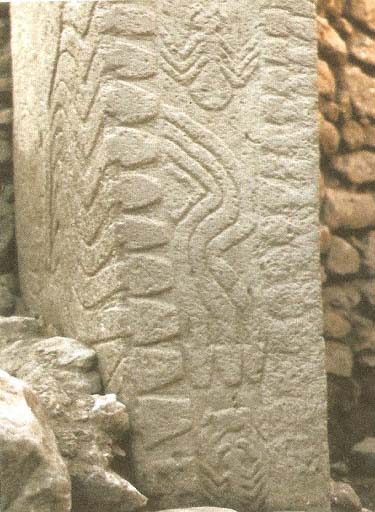
In essence what i suggest is that the pillars represented the Underworld. terrestial plane, and the upper/Heavenly realm, the essential inter-connectivity between these realms and the totemic animals that served such.

Symbolic animals at Gobekli Tepe remains the best paper on what has thus far been uncovered in terms of the nature and number of the beasts, snakes take first place at around 28%, then foxes at 14%, with boars and cranes also very popular.
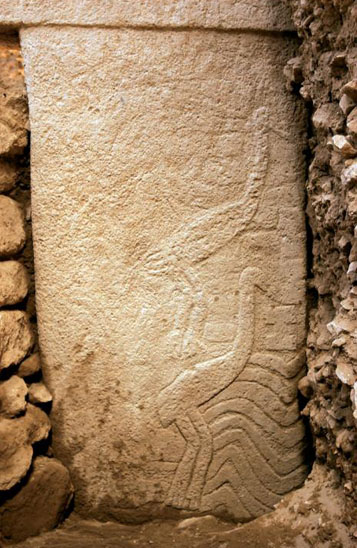
To demonstrate what was involved i'll show a very close comparative which is from China and dates to the Han Dynasty, thus only a couple of thousand years old, and i can only conclude that an entire corpus of evidence for the transmission of these ideas through time and place has been lost, perhaps not too surprisingly if as the funerary banner of Lady Dai they were represented on fabrics.
The Han dynasty funerary banner corresponds to the basic 'T' shape of the Gobekli Tepe pillars, it shows the transiition from the Underworld through to the realm of the Immortals.

The Chinese had a well developed tradition of dragons providing the means of transition through the realms by this period, but at Gobekli Tepe it was the likes of the humble adder that would have sufficed.
Looking at what is involved;
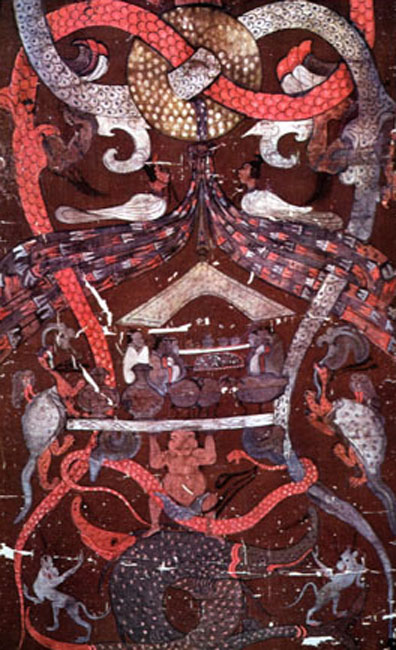
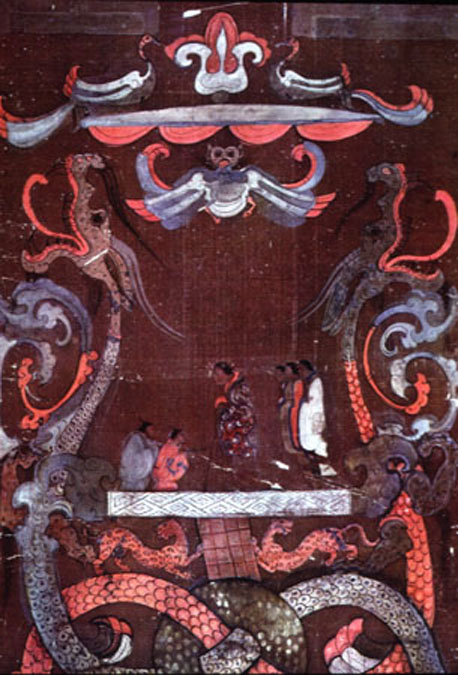
Tomb of Lady Dai
Lady Dai funerary banner
Apart from the obvious role of the snake, the cranes are also strongly represented in the funerary banner, seen at the highest level of the Heavenly realm, the fox also being a traditional shape shifting spirit guide, there is correlation between the function of the Chinese bestiary and that seen at Gobekli Tepe.
There is an intriguing correspondance with the pillars of Gobekli Tepe seen at the entrance into the Heavenly realm, in that the two pillars seen there have parallel inset features, those pillars i need to look into further...

particularly so as they are surmounted by leopards, which are represented also at Gobekli Tepe, and again also had great significance at Catal Hoyuk in conjunction with sacred pillars, within the Goddess shrine;
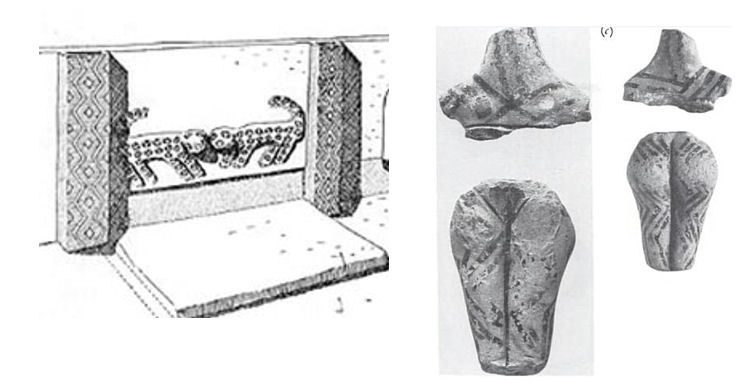
In terms of the greater anthropomorphic elements seen at Gobekli Tepe, and the 'H' motif, that should probably be seen in terms of an overall presiding Deity of nature, the arms and hands, and belts are generally at the level of the navel were the terrestial realm meets with the underworld, from whence spirits became incarnate, the 'H' motif represents the interlinking of two realms, and probably also was developed from practical usage in woodworking, the joining of panels.
The relationship between birth, and transition through levels of being is best seen in the Gobekli Tepe totem, entrance into all three levels would be through a form of birth, and in the totem one sees three inter-connected births, within the overall context of the figure of the birth Goddess.

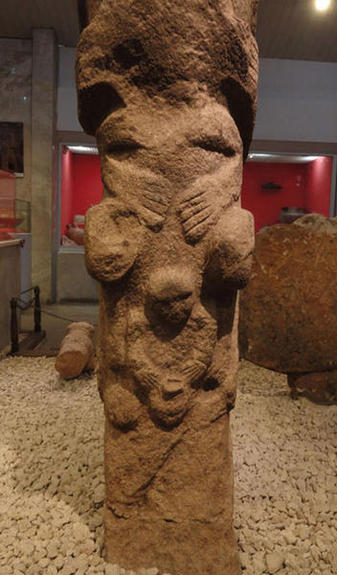
The serpents down the flanks of the figure again reinforce their role in this transition of birth through three realms, very complex iconography for the period, but this does confirm the essential three realm model of the Gobekli Tepe pillars.
There has been evidence from other neolithic sites that the arms and hands seen on the Gobekli Tepe pillars could be related to a birth Goddess, but until now the concept of a triple birth through the three realms has not been conceived...pun intended.
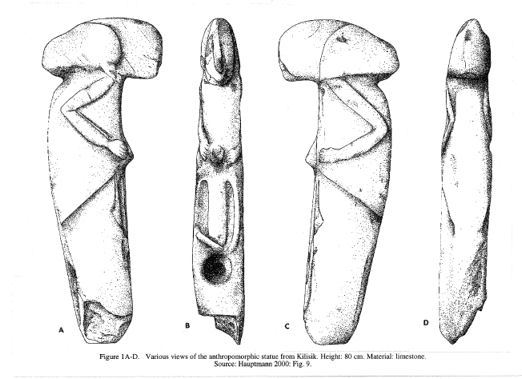
A remaining mystery is the relationship between rectangles and the generation of parabola, the relationship between parabola and serpents, and the relationship between serpents and portals...
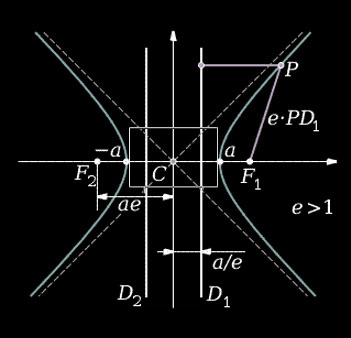
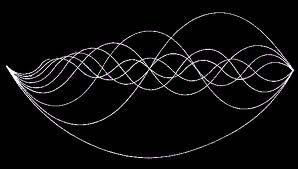
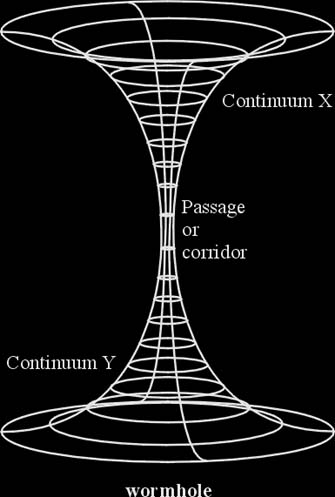
but such understandings would have been of the Gods, and for my part here i have outlined the terms in which the people who constructed the pillars would have seen them.

In general i'll be going along with the current best explanation which is that the animals seen upon them were in some way totemic spirit guides of a shamanic type religious practise, but in particular i'll address the formal geometric structural qualities, for which there is no offered reason, other than they served to hold the roof up..
.

In essence what i suggest is that the pillars represented the Underworld. terrestial plane, and the upper/Heavenly realm, the essential inter-connectivity between these realms and the totemic animals that served such.

Symbolic animals at Gobekli Tepe remains the best paper on what has thus far been uncovered in terms of the nature and number of the beasts, snakes take first place at around 28%, then foxes at 14%, with boars and cranes also very popular.

To demonstrate what was involved i'll show a very close comparative which is from China and dates to the Han Dynasty, thus only a couple of thousand years old, and i can only conclude that an entire corpus of evidence for the transmission of these ideas through time and place has been lost, perhaps not too surprisingly if as the funerary banner of Lady Dai they were represented on fabrics.
The Han dynasty funerary banner corresponds to the basic 'T' shape of the Gobekli Tepe pillars, it shows the transiition from the Underworld through to the realm of the Immortals.

The Chinese had a well developed tradition of dragons providing the means of transition through the realms by this period, but at Gobekli Tepe it was the likes of the humble adder that would have sufficed.
Looking at what is involved;

The lower section of the banner shows the offerings and ceremonies devoted to her body soul (po). Sacrificial vessels are provided for her and attendants are standing next to her, ready to serve her soul which resides in the tomb. Beneath the tomb we get a glimpse of the creatures living in the underworld: A deity of the earth carries the foundation of the tomb, her netherworld dwelling.

The central part of the banner shows Lady Dai in a standing position. She leans on a cane, while two persons crouch or kneel in front of her and three women, presumably female attendants, stand behind her.
The upper part of the banner is said to show the realm of the immortals. The entrance is guarded by two deities holding the records of the life span of Lady Dai. They are identified as deities of destiny.
The scenes are interpreted as showing the modes of existence of the soul after death.
The corpse is placed in the tomb where it is served by underworld attendants. The body soul enjoys and consumes the burial objects and offerings.
At the same time the spirit soul (hun) ascends to the realm of the immortals and seems to rejuvenate during this process.
Tomb of Lady Dai
Lady Dai funerary banner
Apart from the obvious role of the snake, the cranes are also strongly represented in the funerary banner, seen at the highest level of the Heavenly realm, the fox also being a traditional shape shifting spirit guide, there is correlation between the function of the Chinese bestiary and that seen at Gobekli Tepe.
There is an intriguing correspondance with the pillars of Gobekli Tepe seen at the entrance into the Heavenly realm, in that the two pillars seen there have parallel inset features, those pillars i need to look into further...

particularly so as they are surmounted by leopards, which are represented also at Gobekli Tepe, and again also had great significance at Catal Hoyuk in conjunction with sacred pillars, within the Goddess shrine;

In terms of the greater anthropomorphic elements seen at Gobekli Tepe, and the 'H' motif, that should probably be seen in terms of an overall presiding Deity of nature, the arms and hands, and belts are generally at the level of the navel were the terrestial realm meets with the underworld, from whence spirits became incarnate, the 'H' motif represents the interlinking of two realms, and probably also was developed from practical usage in woodworking, the joining of panels.
The relationship between birth, and transition through levels of being is best seen in the Gobekli Tepe totem, entrance into all three levels would be through a form of birth, and in the totem one sees three inter-connected births, within the overall context of the figure of the birth Goddess.


The serpents down the flanks of the figure again reinforce their role in this transition of birth through three realms, very complex iconography for the period, but this does confirm the essential three realm model of the Gobekli Tepe pillars.
There has been evidence from other neolithic sites that the arms and hands seen on the Gobekli Tepe pillars could be related to a birth Goddess, but until now the concept of a triple birth through the three realms has not been conceived...pun intended.

A remaining mystery is the relationship between rectangles and the generation of parabola, the relationship between parabola and serpents, and the relationship between serpents and portals...



but such understandings would have been of the Gods, and for my part here i have outlined the terms in which the people who constructed the pillars would have seen them.
Very Good Post
Some see Gobekli Tepe and others like it as a possible genus of the Garden of Eden story which does'nt sound beyond the realms of the possible.
Some see Gobekli Tepe and others like it as a possible genus of the Garden of Eden story which does'nt sound beyond the realms of the possible.
edit on 6-1-2013 by hotel1 because: (no reason given)
SnF!
I see lots of snakes, sperms, dragons and other fertility or Phallic symbols.
Does anyone have a timeline of the earliest known civilizations to date, and their names?
What people/civilization do we refer to the Gobekli Tepe as, and how far do they go? Are they the oldest we know of?
And what civilizations do we know followed GT on the timetable? Sumerican, Zoroastrian, Vedic, Nubian?
Thanks...
I see lots of snakes, sperms, dragons and other fertility or Phallic symbols.
Does anyone have a timeline of the earliest known civilizations to date, and their names?
What people/civilization do we refer to the Gobekli Tepe as, and how far do they go? Are they the oldest we know of?
And what civilizations do we know followed GT on the timetable? Sumerican, Zoroastrian, Vedic, Nubian?
Thanks...
reply to post by minnow
Gobekli Tepe is the early Neolithic period, circa 11,000 years ago, they don't get classed as a civilization as they didn't have complex cities, their successors just get called Middle then Late period Neolithic cultures for around 6000 years until the bronze age and the first city states...the various branches of Neolithic culture though can be named after specific sites and regions, with Gonekli Tepe being in the core region, Northern Syria/Anatolia..
reply to post by hotel1
The later narratives do source some of the concerns of Gobekli Tepe, serpents, cosmic axis, procreation...perhaps there the components of the myths were first formulated rather than having actually transpired.
reply to post by will2learn
No, they also prevented the ground from floating away...or so the shamen said
Gobekli Tepe is the early Neolithic period, circa 11,000 years ago, they don't get classed as a civilization as they didn't have complex cities, their successors just get called Middle then Late period Neolithic cultures for around 6000 years until the bronze age and the first city states...the various branches of Neolithic culture though can be named after specific sites and regions, with Gonekli Tepe being in the core region, Northern Syria/Anatolia..
reply to post by hotel1
The later narratives do source some of the concerns of Gobekli Tepe, serpents, cosmic axis, procreation...perhaps there the components of the myths were first formulated rather than having actually transpired.
reply to post by will2learn
No, they also prevented the ground from floating away...or so the shamen said
edit on 6-1-2013 by Kantzveldt because: (no reason
given)
Great thread, thought provoking!
What I find awesome as well is that there is so much still to be excavated at the site.
Something like only 10% I think has been unearthed. The site appears to have been buried on purpose, which is a great imagination tickler for myself. I am looking very much forward to the future of this site.S&F
What I find awesome as well is that there is so much still to be excavated at the site.
Something like only 10% I think has been unearthed. The site appears to have been buried on purpose, which is a great imagination tickler for myself. I am looking very much forward to the future of this site.S&F
Originally posted by Kantzveldt
reply to post by will2learn
No, they also prevented the ground from floating away...or so the shamen saidedit on 6-1-2013 by Kantzveldt because: (no reason given)
Kantzvelt
Yes I always worry about the ground floating away or anyone believing what comes out of the mouth of a shaman
With a pelt and rope/wooden beamed roof these would have looked like impressive community buildings alongside the smaller dwellings others have reoconstructed at the site. Of course ppl of the Stone Age are not thought to be that clever despite being able to create megalithic structures like this. They are limited to 10m or so buildings.
Will
reply to post by will2learn
Yes i'm not certain the pillars built into the walls served any great load bearing function for the roof, similar pillars at Nevali Cori seem to have terminated below the height of the walls.
There doesn't appear to be much evidence for communal activity within the buildings, as these are generally touted as the worlds first temples it should perhaps be considered that temples were primarily residences for Deities and not people.
reply to post by mcx1942
Thanks, and yes i'm sure many more interesting discoveries remain at this site.
Yes i'm not certain the pillars built into the walls served any great load bearing function for the roof, similar pillars at Nevali Cori seem to have terminated below the height of the walls.
There doesn't appear to be much evidence for communal activity within the buildings, as these are generally touted as the worlds first temples it should perhaps be considered that temples were primarily residences for Deities and not people.
reply to post by mcx1942
Thanks, and yes i'm sure many more interesting discoveries remain at this site.
edit on 7-1-2013 by Kantzveldt because: (no reason given)
Well done
I like this place a lot,
It gets my imagination going, and i have read about a few theories of the purpouse of these pillars, them being a symbolic ark saved for future mankind or just plain roof support.
But, since it is about 11000 years old im not so sure that we ever will find out the true purpouse.
About the T shape, my guess would be that they didnt do it just for looks, and that the shape where of great importance.
Haha this tau shows up everywhere
Im thinking "hammer of Thor "
Jimmy
I like this place a lot,
It gets my imagination going, and i have read about a few theories of the purpouse of these pillars, them being a symbolic ark saved for future mankind or just plain roof support.
But, since it is about 11000 years old im not so sure that we ever will find out the true purpouse.
About the T shape, my guess would be that they didnt do it just for looks, and that the shape where of great importance.
Haha this tau shows up everywhere
Im thinking "hammer of Thor "
Jimmy
reply to post by jisujaaljo
Thanks, i can never leave the true purpose of religious iconography alone, i always keep digging until i find an answer that at least satisfies myself, if no-one else...
Thanks, i can never leave the true purpose of religious iconography alone, i always keep digging until i find an answer that at least satisfies myself, if no-one else...
original post by: KantzVeldt
A remaining mystery is the relationship between rectangles and the generation of parabola, the relationship between parabola and serpents, and the relationship between serpents and portals...
A conclusion I have drawn, is:
A parabola seems to be a (connecting / bridging) line...represented as a 'serpent'. Since the 'purpose' or act of the parabola (line / serpent) seems to (connect / bridge); therefore can be perceived as a "portal' of such, to pass to any given point on the (parabola / serpents) 'path'.
I am still pondering on the 'possibilities' of parabola (creation / generation)....
~My thoughts ~ further discussion most welcome.
[color=RED] ThatGuy45
edit on 7/1/13 by ThatGuy45 because: (no reason given)
Gobelki Tepe reminds me of the Mayan/Aztec culture.
They also revered the "T" shape and incorporated it in their buildings.
It is possible that Gobelki is a time capsule of sorts and most likely a
cyclical clock such as Stonehenge.
One thing for sure - Gobelki Tepe proves ancient man is above the credentials
we modern day humans give them credit for.
They also revered the "T" shape and incorporated it in their buildings.
It is possible that Gobelki is a time capsule of sorts and most likely a
cyclical clock such as Stonehenge.
One thing for sure - Gobelki Tepe proves ancient man is above the credentials
we modern day humans give them credit for.
reply to post by ThatGuy45
When i discuss inter-connectivity between the Underworld, terrestial plane, and the upper world around these parts i get a distinct sense of general dis-interest, that this is just the same old boring mythology and offers nothing new to a popular culture weary of tales of Heaven and Hell.
However, research shows that the likes of the Maya and Egyptians did not think as the Underworld, the place where creation was first generated as being a cavern underground, though it appears thus in symbolic representation with regards to spiritual transformation, but rather they considered the Orion Nebula in terms of the place of celestial birth.
At one level the entrance into the underworld can simply be a hole in the ground a lair of wriggly snakes, but at the most profound you'd be looking at the relationship of the Earth to the Orion Nebula, and any dragons that could connect you to that would have to be quite spectacular...

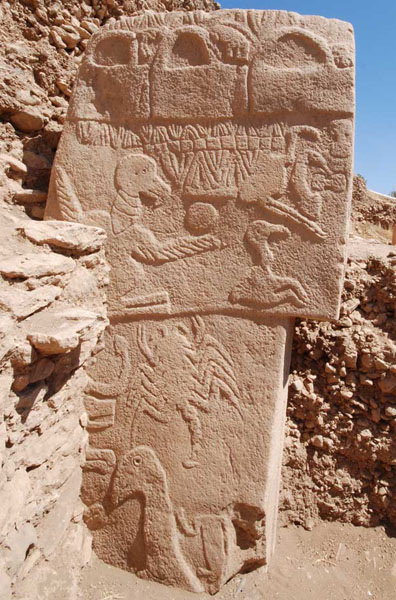
Research into those dragons must continue.
reply to post by HumAnnunaki
At a site such as Nevali Cori or Gobekli Tepe, the oldest temples in the whole wide world, it's maybe best to think of the T shaped pillars as keys, in the sense that they have relationship to the four horizons, and the portals associate with them, the gateways into the Heavens.
The rectilinear x-y co-ordinate regular simplicity can lend itself to the generation of parabola, winding snakes that love these columns, and it's these snakes that do the magical stuff...

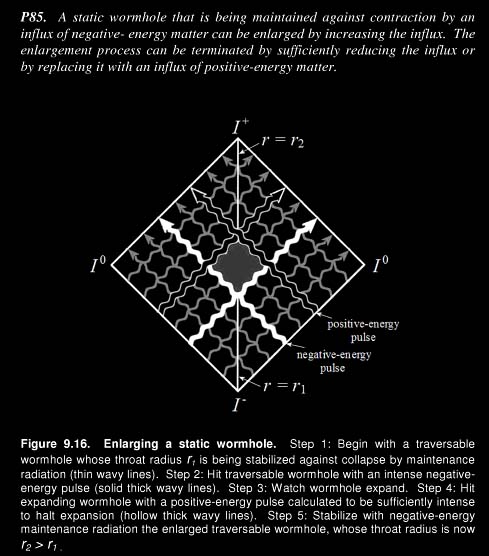
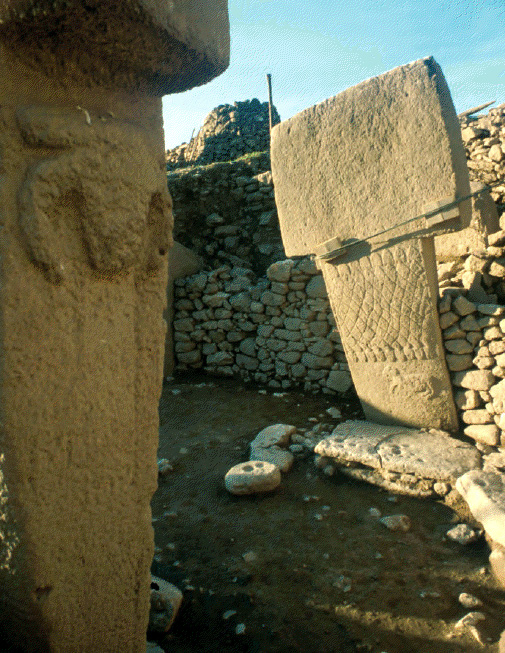
When i discuss inter-connectivity between the Underworld, terrestial plane, and the upper world around these parts i get a distinct sense of general dis-interest, that this is just the same old boring mythology and offers nothing new to a popular culture weary of tales of Heaven and Hell.
However, research shows that the likes of the Maya and Egyptians did not think as the Underworld, the place where creation was first generated as being a cavern underground, though it appears thus in symbolic representation with regards to spiritual transformation, but rather they considered the Orion Nebula in terms of the place of celestial birth.
At one level the entrance into the underworld can simply be a hole in the ground a lair of wriggly snakes, but at the most profound you'd be looking at the relationship of the Earth to the Orion Nebula, and any dragons that could connect you to that would have to be quite spectacular...


Research into those dragons must continue.
reply to post by HumAnnunaki
At a site such as Nevali Cori or Gobekli Tepe, the oldest temples in the whole wide world, it's maybe best to think of the T shaped pillars as keys, in the sense that they have relationship to the four horizons, and the portals associate with them, the gateways into the Heavens.
The rectilinear x-y co-ordinate regular simplicity can lend itself to the generation of parabola, winding snakes that love these columns, and it's these snakes that do the magical stuff...



edit on 7-1-2013 by Kantzveldt because: (no reason given)
edit on 7-1-2013 by Kantzveldt because: (no reason given)
If our locations and moments are distinct is this medium upon which we converse not a wormhole?
Is a wormhole about the speed of traversal or the distance traversed?
Awake is the new sleep.
Is a wormhole about the speed of traversal or the distance traversed?
Awake is the new sleep.
edit on 7-1-2013 by usernamehere because: sky-net made me do it
reply to post by usernamehere
As far as my knowledge of Astro-physics goes i believe its about the collapsing of time and space into a vortex...
As far as my knowledge of Astro-physics goes i believe its about the collapsing of time and space into a vortex...
From what I gather:
Wormhole creation requires perceived Time and Space to be collapsed, or even 'condensed' into a vortex of immense-concentrated energy ... at which point direction-destination (would / could) be in direct correlation with the specific concentrated energy used to create said vortex and the 'events' surrounding and/or contained in the perceived time/space at the moment of creation...
Then the question would stand: how does one (dictate / guide) this vortex to produce a desired outcome?
[color=RED]ThatGuy45
Wormhole creation requires perceived Time and Space to be collapsed, or even 'condensed' into a vortex of immense-concentrated energy ... at which point direction-destination (would / could) be in direct correlation with the specific concentrated energy used to create said vortex and the 'events' surrounding and/or contained in the perceived time/space at the moment of creation...
Then the question would stand: how does one (dictate / guide) this vortex to produce a desired outcome?
[color=RED]ThatGuy45
reply to post by ThatGuy45
Traditionaly with one of these...
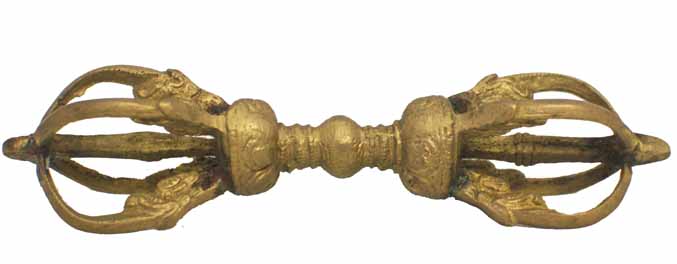
The Dorje generates spiral fields of energy
Stargates of Tibet
The Chinese concerned themselves with the inter-connectivity of these spirals.
Stargates of China
I need to get around to investigating also Southern Death Cult representation of the Dorje;
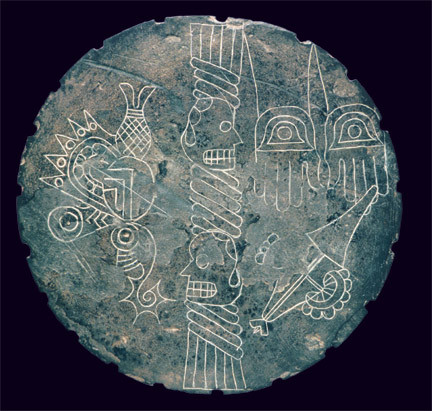
Traditionaly with one of these...

The Dorje generates spiral fields of energy
Stargates of Tibet
The Chinese concerned themselves with the inter-connectivity of these spirals.
Stargates of China
I need to get around to investigating also Southern Death Cult representation of the Dorje;

edit on 9-1-2013 by Kantzveldt because: (no reason given)
Hi,
This image (below) is a natural rock formation in Anatolia, Turkey. It is said to have the appearance of mushrooms.
Certain mushrooms, of course, have halucinogenic properties whereby all manner of animals such as snakes (serpents) etc are seen. If Gobekli Tepe was a Shamanic Temple and if the shamans used mushrooms to enter into a shamanic state then perhaps these pillars represent such mushrooms?
Regards,
SC
This image (below) is a natural rock formation in Anatolia, Turkey. It is said to have the appearance of mushrooms.
Certain mushrooms, of course, have halucinogenic properties whereby all manner of animals such as snakes (serpents) etc are seen. If Gobekli Tepe was a Shamanic Temple and if the shamans used mushrooms to enter into a shamanic state then perhaps these pillars represent such mushrooms?
Regards,
SC
reply to post by Scott Creighton
Hi Scott, that's a usefull insight, mushrooms can provide a low tech means of transit between Heaven and the Underworld, i still suspect there is an advanced mathematics and astro-physics method.

how does we makes it wurk precious...
Hi Scott, that's a usefull insight, mushrooms can provide a low tech means of transit between Heaven and the Underworld, i still suspect there is an advanced mathematics and astro-physics method.

how does we makes it wurk precious...
edit on 9-1-2013 by Kantzveldt because: (no reason given)
Originally posted by Kantzveldt
Gobekli Tepe is the early Neolithic period, circa 11,000 years ago, they don't get classed as a civilization...
Well, why not? Maybe no cities have been found, but the "T"-shaped columns with a horizontal line to delineate the upper bar, suggests a long history of post-and-lintel construction. Maybe not a civilization according to our standards, but why should we judge such a society as uncivilized? "Civilization" 11,000 years ago - I think the establishment is just not willing to make the stretch...
new topics
-
Former NYT Reporter Attacks Scientists For Misleading Him Over COVID Lab-Leak Theory
Education and Media: 58 minutes ago -
Why did Phizer team with nanobot maker
Medical Issues & Conspiracies: 1 hours ago -
Pro Hamas protesters at Columbia claim hit with chemical spray
World War Three: 1 hours ago -
Elites disapearing
Political Conspiracies: 3 hours ago -
A Personal Cigar UFO/UAP Video footage I have held onto and will release it here and now.
Aliens and UFOs: 3 hours ago -
Go Woke, Go Broke--Forbes Confirms Disney Has Lost Money On Star Wars
Movies: 5 hours ago -
Freddie Mercury
Paranormal Studies: 6 hours ago -
Nirvana - Immigrant Song
Music: 10 hours ago -
British TV Presenter Refuses To Use Guest's Preferred Pronouns
Education and Media: 11 hours ago
top topics
-
British TV Presenter Refuses To Use Guest's Preferred Pronouns
Education and Media: 11 hours ago, 16 flags -
Go Woke, Go Broke--Forbes Confirms Disney Has Lost Money On Star Wars
Movies: 5 hours ago, 12 flags -
Pro Hamas protesters at Columbia claim hit with chemical spray
World War Three: 1 hours ago, 9 flags -
Trump To Hold Dinner with President of Poland At Trump Tower Tonight
2024 Elections: 14 hours ago, 8 flags -
Tucker Carlson interviews Christian pastor from Bethlehem.
Middle East Issues: 13 hours ago, 7 flags -
Elites disapearing
Political Conspiracies: 3 hours ago, 7 flags -
A family from Kansas with six children moved to the Moscow region
Other Current Events: 17 hours ago, 6 flags -
Freddie Mercury
Paranormal Studies: 6 hours ago, 6 flags -
A Personal Cigar UFO/UAP Video footage I have held onto and will release it here and now.
Aliens and UFOs: 3 hours ago, 5 flags -
Nirvana - Immigrant Song
Music: 10 hours ago, 4 flags
active topics
-
Trump To Hold Dinner with President of Poland At Trump Tower Tonight
2024 Elections • 36 • : ImagoDei -
British TV Presenter Refuses To Use Guest's Preferred Pronouns
Education and Media • 46 • : Unknownparadox -
Elites disapearing
Political Conspiracies • 14 • : AwakeNotWoke -
Freddie Mercury
Paranormal Studies • 1 • : AwakeNotWoke -
Why did Phizer team with nanobot maker
Medical Issues & Conspiracies • 1 • : AwakeNotWoke -
Pro Hamas protesters at Columbia claim hit with chemical spray
World War Three • 6 • : DBCowboy -
Former NYT Reporter Attacks Scientists For Misleading Him Over COVID Lab-Leak Theory
Education and Media • 1 • : Dandandat3 -
Gold and silver prices....woo hoo
History • 75 • : SchrodingersRat -
-@TH3WH17ERABB17- -Q- ---TIME TO SHOW THE WORLD--- -Part- --44--
Dissecting Disinformation • 512 • : cherokeetroy -
A Personal Cigar UFO/UAP Video footage I have held onto and will release it here and now.
Aliens and UFOs • 9 • : Ophiuchus1

